7 SDR Functions To Run A Great Account-Based Marketing (ABM) Program

In today’s competitive B2B landscape, a well-executed Account-Based Marketing (ABM) program can set a company apart from its competitors.
Sales Development Representatives (SDRs) play a crucial role in the success of an ABM strategy. Their functions, when executed effectively, can make a significant impact on generating high-value sales opportunities.
In this guide, we will discuss:
- What are SDRs
- Key functions of a SDR in ABM
- KPIs for SDRs
Let’s dive in!
What Are SDRs?
Sales Development Representatives (SDRs) are pivotal members of the sales team, focusing on the early stages of the sales process. Their primary role is to generate and qualify leads, setting the stage for the sales team to close deals.
7 Key Functions of an SDR in ABM
Here’s a look at seven key SDR functions that are essential for running a successful ABM program.
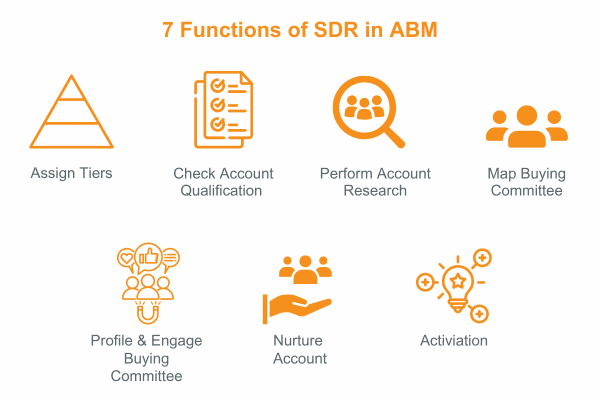
1. Assign Tier Based on Revenue Potential
Not all accounts are created equal. SDRs should categorize accounts into tiers based on their revenue potential and strategic importance.
- Tier 1 – Highest Revenue Potential
- Tier 2 – Medium Revenue Potential
- Tier 3 – Lowest Revenue Potential
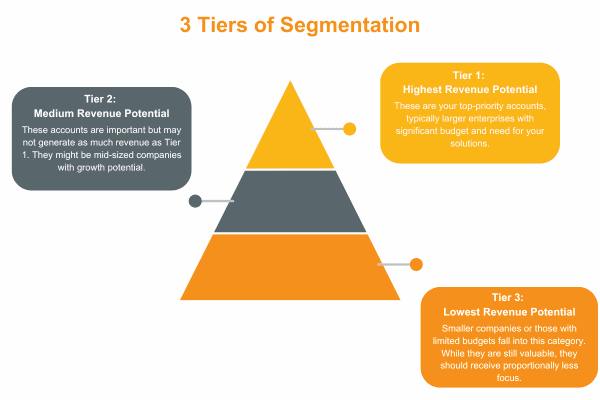
This tiering helps prioritize efforts and tailor approaches to the accounts that offer the highest value.
2. Check Account Qualification & Disqualification Criteria
Before diving into an ABM program, it’s crucial to ensure that each account is a good fit.
SDRs should meticulously assess if an account meets all the required qualification criteria. This includes evaluating the account’s size, industry, and needs to ensure alignment with your ideal customer profile.
By setting these criteria, you can avoid wasting resources on accounts that are unlikely to convert.
3. Perform Account Research
Effective ABM relies on a deep understanding of each account and its decision-making process.
To help craft relevant and compelling messaging, identify the challenges an account may face by using:
- Intent data
- Market signals
- Key initiatives
Accounts should be grouped into clusters based on their identified challenges to allow for more targeted and effective outreach strategies.
4. Map Buying Committee
Identifying and understanding the roles of different members within the buying committee allows SDRs to tailor their strategies and communications. Here’s how to define and engage with each type of buyer within the committee.
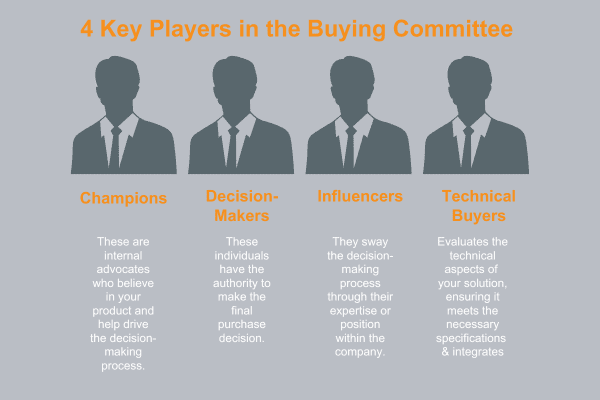
Champions
Champions are the advocates within the organization who support and promote your solution internally. They often influence other committee members and are passionate about solving the problem your product addresses.
Decision-makers
Decision-Makers are the individuals who have the authority to approve the purchase. They are typically higher up in the organizational hierarchy and are concerned with the strategic fit and financial implications of your solution.
Influencers
Influencers are individuals who may not have final approval authority but can significantly impact the decision-making process. They often provide recommendations and feedback based on their expertise or role within the organization.
Technical buyers
Technical Buyers are responsible for evaluating the technical aspects of your solution, ensuring it meets the necessary specifications and integrates well with existing systems. They are typically more concerned with functionality, compatibility, and technical support.
5. Profile & Engage Buying Committee
ABM’s success heavily depends on the relationship with the buying committee members SDRs will be able to establish.
Instead of calling or bombarding everybody with cold emails, SDRs should update their outreach to more modern methods.
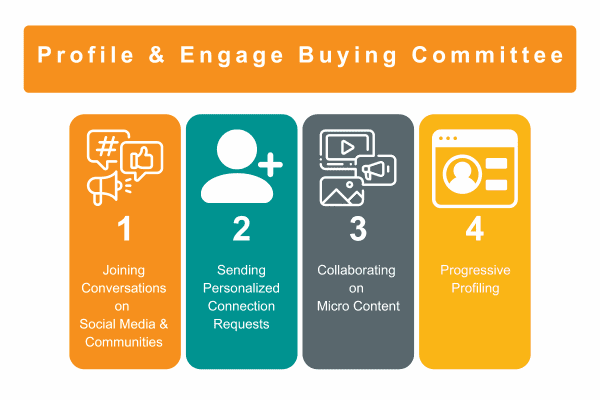
Joining Conversations on Social Media & Communities
Engage with target buyers in relevant social media platforms and professional communities. This helps in understanding their needs and establishing rapport.
Sending Personalized Connection Requests
Avoid generic outreach. Personalized connection requests are more likely to be accepted and can pave the way for meaningful interactions.
Collaborating on Micro Content
Work with the marketing team to create micro-content that resonates with the buying committee. This could include blog posts, infographics, or short videos.
Progressive Profiling
Gradually gather information to gain a deeper understanding of account challenges and the buyer’s journey stage. This allows for more tailored and relevant communications.
6. Nurture Account
Nurturing accounts through the buying process is key to converting opportunities. SDRs should leverage content that addresses the specific challenges faced by the account to support change management efforts, maintain engagement, and provide value.
Establishing your company’s expertise through thought leadership content and repurposing existing cluster content helps in staying top-of-mind with the account.
Additionally, inviting accounts to relevant webinars, workshops, or industry events that align with their interests can further engage and nurture the relationship.
7. Activation
For accounts that are not currently in market, the SDR needs to bridge the gap between the ABM program and sales opportunities.
- Leverage Feedback – Collecting feedback about cluster content and events provides insights into what resonates with the target accounts.
- Personalize Cases – Creating personalized business cases based on account research and profiling helps in demonstrating the specific value of your solution.
- Connect Buyers – Connecting target buyers with internal Subject Matter Experts (SMEs) or peers working for your clients can assist with addressing specific challenges and building stronger relationships.
So, how do you know if you’re successful?
KPIs in ABM Programs for SDRs
To measure the effectiveness of their efforts, specific Key Performance Indicators (KPIs) are used to track performance and optimize strategies.
Here are three critical KPIs for SDRs working in ABM programs.
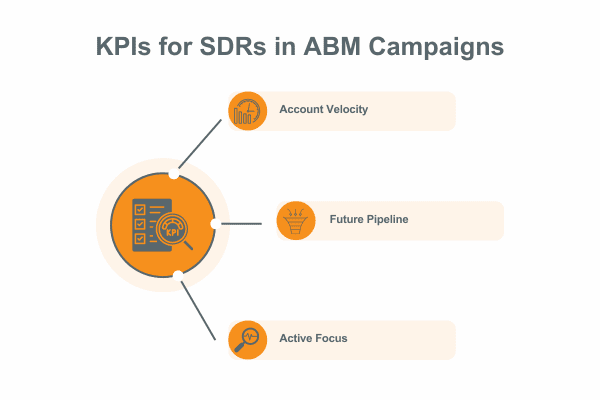
Account Velocity
Account velocity measures the speed at which target accounts move through the sales funnel, from initial engagement to closed deals. In ABM, SDRs work on building deep relationships with key accounts, so understanding how quickly these accounts progress is vital.
You should also track how many high-potential accounts—those with clear product needs, familiarity with your brand, and strong relationships—are being properly researched, reached out to, and scheduled for discovery calls.
A higher velocity indicates that the SDR is effectively engaging with decision-makers, overcoming objections, and pushing deals toward closure more efficiently.
Future Pipeline
In ABM, success is not only about the current deals but also about building a robust future pipeline. Future pipeline refers to the potential opportunities created for future sales.
SDRs are responsible for identifying and nurturing accounts that may not be in the immediate buying cycle but show promise for the future. At this stage, the goal is to further explore and validate the account’s challenges and product requirements, and engage more members of the buying committee.
KPIs:
- Account-to-conversation ratio
- Account penetration
Active Focus
In ABM, SDRs are not focused on volume but rather on quality. Active focus is about identifying and targeting accounts that have a high likelihood of becoming sales opportunities in the current period.
These are the accounts that align with your ICP (Ideal Customer Profile) and are being targeted with personalized outreach efforts. The
KPIs:
- Account-to-pipeline ratio
- Sales pipeline velocity
Increase Your ROI With SDRs
SDRs are essential for creating a strong foundation for ABM success. Their efforts in generating and qualifying leads, conducting account research, and nurturing relationships are critical to driving revenue growth and optimizing the process.
These KPIs provide a clear view of how well SDRs are driving engagement, converting high-value accounts, and ensuring future sales opportunities.
By focusing on these metrics, SDRs can align their efforts more closely with the strategic goals of the ABM program, ultimately delivering better results for the business.
Does your SDR need a marketing team to work with? Get in touch with our team of digital marketing strategists today








